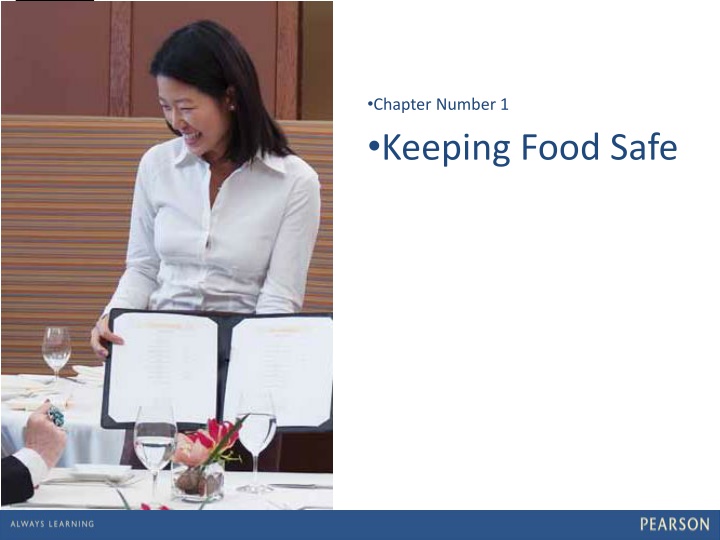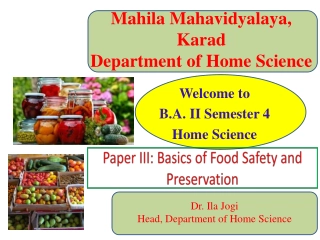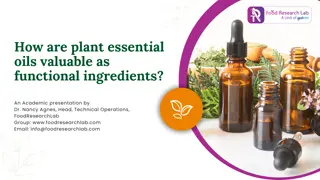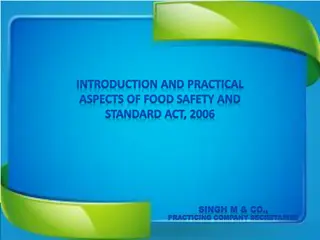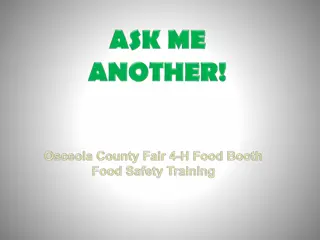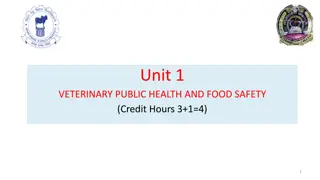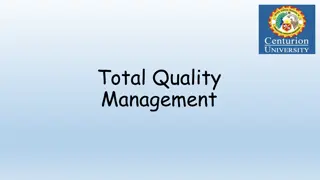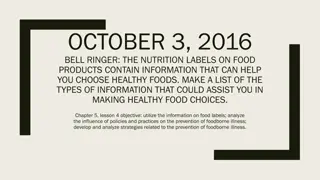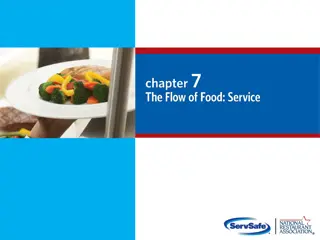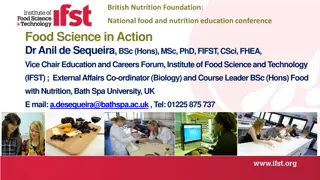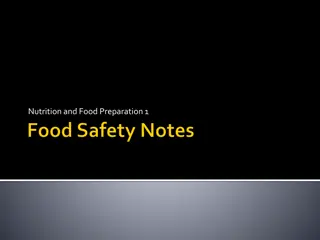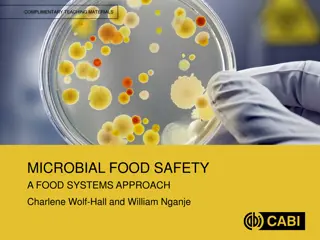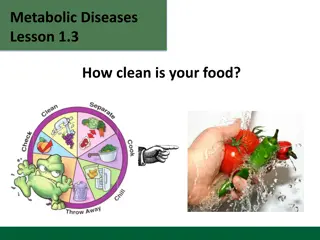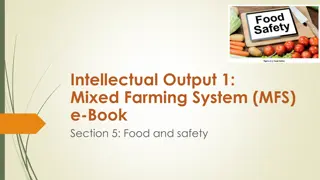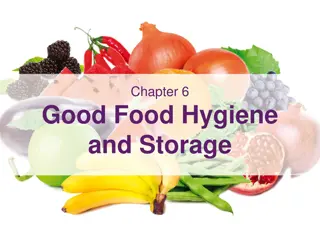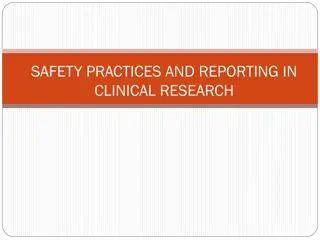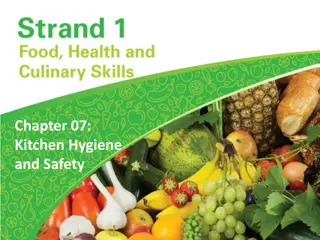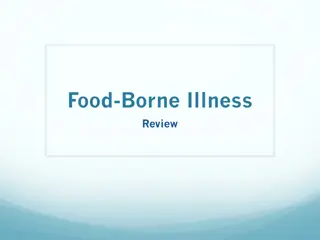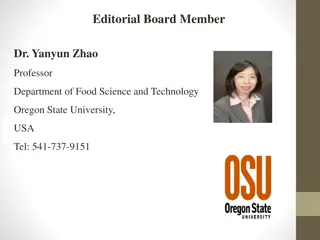Food Safety: Essential Knowledge and Practices
Exploring the fundamentals of keeping food safe, this content covers topics such as foodborne illnesses, contaminants, food safety responsibilities, key terms like time-temperature abuse and cross-contamination, and high-risk populations. Discover how to identify foodborne illnesses and recognize factors that contribute to unsafe food.
Download Presentation

Please find below an Image/Link to download the presentation.
The content on the website is provided AS IS for your information and personal use only. It may not be sold, licensed, or shared on other websites without obtaining consent from the author.If you encounter any issues during the download, it is possible that the publisher has removed the file from their server.
You are allowed to download the files provided on this website for personal or commercial use, subject to the condition that they are used lawfully. All files are the property of their respective owners.
The content on the website is provided AS IS for your information and personal use only. It may not be sold, licensed, or shared on other websites without obtaining consent from the author.
E N D
Presentation Transcript
Chapter Number 1 Keeping Food Safe 1
1.0 Learning Objectives After this presentation, you should be able to complete the following Learning Outcomes What a foodborne illness is and determine when it has occurred 1.1 1.2 Challenges to food safety Costs of a foodborne illness 1.3 Contaminants that can make food unsafe 1.4 How food becomes unsafe 1.5 2
1.0 Learning Objectives After this presentation, you should be able to complete the following Learning Outcomes Food most likely to become unsafe 1.6 Populations at high risk for foodborne illness 1.7 Food safety responsibilities of the person in charge of a foodservice operation 1.8 3
1.0 KEY TERMS Foodborne illness: Illness carried or transmitted to people by food. Contamination: Presence of harmful substances in food. Some food safety hazards occur naturally, while others are introduced by humans or the environment. Foodborne illness outbreak: An incident in which two or more people experience the same illness symptoms after eating the same food. An investigation is conducted by the state and local regulatory authorities, and the outbreak is confirmed by a laboratory analysis.
1.0 KEY TERMS Time-temperature abuse: Food has been time- temperature abused any time it has been allowed to remain too long at a temperature favorable to the growth of foodborne microorganisms. Cross-contamination occurs when microorganisms are transferred from one food or surface to another. TCS food: Food that contains moisture and protein and has a neutral or slightly acidic pH. Such food requires time- temperature control to prevent the growth of microorganisms and the production of toxins.
1.0 KEY TERMS Ready-to-eat food: Any food that is edible without further preparation, washing, or cooking. It includes washed fruit and vegetables, both whole and cut; deli meats; and bakery items. Sugars, spices, seasonings, and correctly cooked food items are also considered ready-to-eat. High-risk populations: People susceptible to foodborne illness due to the effects of age or health on their immune systems, including infants and preschool-age children, pregnant women, older people, people taking certain medications, and those with certain diseases or weakened immune systems. Immune system: The body s defense\system against illness. People with compromised immune systems are more susceptible to foodborne illness.
1.1 Identify Foodborne Illness and Recognize when it has occurred Foodborne Food What is Foodborne Illness? Illness Illness 7
Identify Foodborne Illness and Recognize when it has occurred 1.1 How is foodborne illness identified? Two or more people believe they got ill from the same source Investigation completed by a regulatory authority, e.g. FDA, USDA, County Health Dept., etc. Analysis of regulatory findings by a laboratory Laboratory releases report that either supports or contradicts the original findings Final Report Released and Possible Foodborne Illness Confirmed or Ruled Out Findings and Samples Sent to Lab and Analyzed Two People Get Ill From the Same Source Regulatory Authority Investigates 8
1.2 Challenges to Food Safety Time Unapproved Suppliers Language/Cu lture Foodborne Illness High-Risk Populations Education Staff Turnover Pathogens 9
1.3 Costs of Foodborne Illness Why is the Cost of Foodborne Illness so High?
1.3 Costs of Foodborne Illness
1.4 Contaminants Chemical Biological Physical Cleaning Soluntions, Sanitizers, Polishers, etc. Pathogens, e.g., Bacteria, Viruses, Parasites, Harmful Plant and Animal Toxins Staples, Bandages, Glass, Dirt, Metal Shavings, etc.
1.4 Contaminants Chemical Biological Physical Contamination Foodborne Illness
1.5 Keeping Food Safe Time and Temperature Abuse 14
1.5 Keeping Food Safe Pathogens Cross Contamination 15
1.5 Keeping Food Safe Coughing& Sneezing Not WashingHands Poor Personal Hygiene Touching or Scratching Working While Wounds Sick 16
1.6 Identifying Potentially Hazardous Food Milk and Dairy Poultry Shell Eggs Fish Beef, Pork, & Lamb Shellfish
1.6 Identifying Potentially Hazardous Food Sprouts & Sprout Seeds Baked Potatoes Melons, Tomato, Greens Cooked Rice, Beans, or Vegetables Garlic/Oil Mixes Soy and Soy Products
1.7 High-Risk Populations What are some examples of people who are in high-risk populations for contracting a foodborne illness?
1.7 High-Risk Populations The Elderly Preschool- Aged Children The Immune - Compromised
1.8 Responsibilities of a Manager Proper Receiving Non Employees Food Handlers Time/Temperature Abuse Proper Hand Washing Food Prepared in Private Home
1.8 Responsibilities of a Manager Cleaning and Sanitation Proper Glove Use Written Guidelines for Food Safety Food Safety Training Raw or Undercooked Meat Warnings
